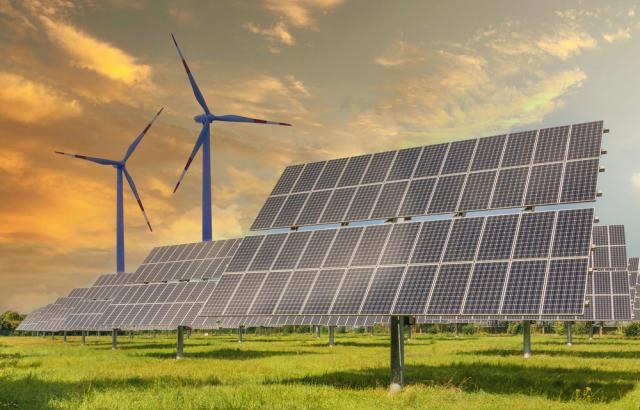
The rush by developed economies worldwide to add renewable power has created a freak pattern in wholesale electricity markets: negative power prices during the afternoons and spiking costs by evening. (Source: Shutterstock.com)
Renewable power sources offer an embarrassment of riches during the day — and, increasingly, just embarrassment at night.
The rush by developed economies worldwide to add renewable power has created a freak pattern in wholesale electricity markets: negative power prices during the afternoons and spiking costs by evening.
What began as an aberration in power pricing appears to be shaping into the new normal, according to a June report by Bernstein analyst Nikhil Nigania.
In Australia, California, India and Europe, governments and homeowners have been busily adding solar panels — along with additional wind capacity. Bernstein says the problem is that little forethought was spent on developing power-on-demand solutions for nighttime.
“The integration of renewables, we think, will be much more challenging than governments are anticipating,” Nigania wrote.
A key problem is the lack of dispatchable power to address peak power usage, either from batteries or pumped hydro storage systems. Pumped storage uses electricity during low-demand periods to pump water into upper reservoirs. At high-demand periods, the stored water is released and flows through turbines to generate electricity, according to the National Hydropower Association.
The need for dispatchable power is so great that automaker Ford has marketed its F-150 Lightning pickup as a battery backup to complement home solar installations, Bernstein noted.
Without dispatchable capacity, most countries “are likely to see substantial over-supply of power in the afternoon (with rising intensity of negative prices) and shortages in the evening hours,” Bernstein analysts said. “This is creating a big power price arbitrage within the day power prices and evening power prices which we think will only increase with time.”
India, which Bernstein has assessed as the third cheapest geography for solar power generation globally, continues to add solar but lacks enough natural gas or hydropower to play a balancing role. Some 71% of India's generation is met by coal-based plants which are inflexible to a large extent, as Indian coal plants can run at a minimum load of 55%.
“With rising renewable and inflexible solar, an immediate consequence can be seen in power prices on India's power exchange over the last month,” Bernstein said. During the day, power prices fall below the marginal cost of most coal-based plants. In the evening, they are five times more expensive.
As a result, storage businesses are thriving. Even companies with pumped storage in their names have received a boost.
“The euphoria around pumped is very visible … where even signing of a Memorandum of Understanding (MoU) with the government to set up a plant (which will come after 6-8 years) is driving stock prices up by 10-15%,” the report said.
Quoting a friend, Bernstein’s Nigania noted that “pumped storage is the AI of the power sector."
Unintended consequences
In California, with the second highest electricity consumption in the U.S. after Texas, the state witnessed a rising frequency in negative electric prices mainly in the months of February to May — peaking in March and April.
In those months, the state experiences the most sunshine but does not see a rise in power demand.
“The intensity of these negative prices is only increasing with time,” the report noted. “The afternoon net-load on the system continues to come down with the large penetration of rooftop solar and grid-connected solar.”
The evening net-load has only seen a slight dip due to wind. California power demand also peaks in the evening from 5 p.m. to 8 p.m.
“Hence, we are seeing a pattern similar to most other geographies with afternoon troughs and morning/ evening peaks.”
This skewed demand-supply is also causing massive curtailments in solar and wind generation. In April 2022, 600 gigawatt-hours of power generation were curtailed — meaning that “10% of renewable generation [was] wasted,” Bernstein’s report said.
Another consequence: California has reduced incentives for rooftop solar additions, with excess power from rooftop installations paying less. Previously, power generated from a rooftop installation in the afternoon would be netted off from grid power consumed in the evening. Now, excess generation during the afternoon pays consumers $0.03 per kilowatt-hour.
“Now people are either avoiding rooftop solar altogether or installing solar and battery,” the report said.
Europe hasn’t been immune to negative power pricing. Rising wind and solar generation added to the grid, combined with warmer temperatures and uncertainty on gas and coal prices has resulted in wide volatility in prices.
“While overall Europe saw [a] higher number of negative power instances in … 2020 and 2021 during COVID, the instances are now rising again with Q4 22 … 157% higher in the observed bidding zones than in the Q4 21.”
As in the U.S., Bernstein thinks that negative prices in Europe “will only rise in both frequency and intensity.”
Recommended Reading
Galp Seeks to Sell Stake in Namibia Oilfield After Discovery, Sources Say
2024-04-22 - Portuguese oil company Galp Energia has launched the sale of half of its stake in an exploration block offshore Namibia.
E&P Highlights: March 11, 2024
2024-03-11 - Here’s a roundup of the latest E&P headlines, including a new bid round offshore Bangladesh and new contract awards.
Empire Petroleum’s Williston Drilling Program Identifies New Zones
2024-05-16 - Empire Petroleum provided updates on its Williston Basin development drilling program in its first quarter 2024 earnings results.
Diamondback May Go Nuclear to Power Permian Basin Ops
2024-04-08 - Oklo Inc., a California fission power plant developer, on April 8 said it signed a letter of intent to collaborate with Diamondback Energy on implementation of nuclear energy for drilling operations in the Permian Basin.
Exclusive: Carbo Sees Strong Future Amid Changing Energy Landscape
2024-03-15 - As Carbo Ceramics celebrates its 45th anniversary as a solutions provider, Senior Vice President Max Nikolaev details the company's five year plan and how it is handling the changing energy landscape in this Hart Energy Exclusive.





